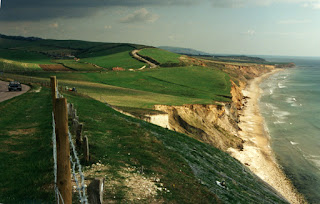Another examination by Palaeontologists at the University of Southampton proposes four bones as of late found on the Isle of Wight have a place with new types of theropod dinosaur, the gathering that incorporates Tyrannosaurus rex and current winged animals.
The dinosaur lived in the Cretaceous time frame 115 million years back and is assessed to have been up to four meters in length.

The bones were found on the foreshore at Shanklin a year ago and are from the neck, back and tail of the new dinosaur, which has been named Vectaerovenator inopinatus.
The name alludes to the huge air spaces in a portion of the bones, one of the qualities that helped the researchers distinguish its theropod starting points. These air sacs, likewise found in present day winged animals, were expansions of the lung, and it is likely they helped fuel a proficient breathing framework while additionally making the skeleton lighter.
The fossils were found over a time of weeks in 2019 out of three separate revelations, two by people and one by a family gathering, who all submitted their finds to the close by Dinosaur Isle Museum at Sandown.
The logical investigation has affirmed the fossils are probably going to be from a similar individual dinosaur, with the specific area and timing of the discovers adding to this conviction.
Robin Ward, a customary fossil tracker from Stratford-upon-Avon, was with his family visiting the Isle of Wight when they made their revelation. He stated: "The delight of finding the bones we found was totally phenomenal. I thought they were exceptional thus took them along when we visited Dinosaur Isle Museum. They quickly knew these were something uncommon and inquired as to whether we could give them to the historical center to be completely explored."

James Lockyer, from Spalding, Lincolnshire was additionally visiting the Island when he found one more of the bones. Additionally an ordinary fossil tracker, he stated: "It appeared to be unique from marine reptile vertebrae I have run over before. I was looking through a spot at Shanklin and had been told and perused that I wouldn't discover much there. In any case, I generally ensure I search the regions others don't, and on this event it paid off."
Paul Farrell, from Ryde, Isle of Wight, included: "I was strolling along the sea shore, kicking stones and went over what resembled a bone from a dinosaur. I was truly stunned to discover it could be another species."
In the wake of considering the four vertebrae, scientistss from the University of Southampton affirmed that the bones are probably going to have a place with a variety of dinosaur beforehand obscure to science. Their discoveries will be distributed in the diary Papers in Paleontology, in a paper co-wrote by the individuals who found the fossils.
Chris Barker, a PhD understudy at the college who drove the examination, stated: "We were struck by exactly how empty this creature was - it's filled with air spaces. Portions of its skeleton more likely than not been somewhat sensitive.
"The record of theropod dinosaurs from the 'mid' Cretaceous period in Europe isn't unreasonably incredible, so it's been truly energizing to have the option to build our comprehension of the assorted variety of dinosaur species from this time.
"You don't typically discover dinosaurs in the stores at Shanklin as they were set down in a marine natural surroundings. You're substantially more liable to discover fossil shellfish or flotsam and jetsam, so this is an uncommon find for sure."
All things considered, the Vectaerovenator lived in a territory only north of where its remaining parts were found, with the body having cleaned out into the shallow ocean close by.
Chris Barker included: "Despite the fact that we have enough material to have the option to decide the overall kind of dinosaur, we'd in a perfect world like to discover more to refine our investigation. We are thankful for the gift of these fossils to science and for the significant job that resident science can play in fossil science."
The Isle of Wight is eminent as one of the top areas for dinosaur stays in Europe, and the new Vectaerovenator fossils will currently go in plain view at the Dinosaur Isle Museum at Sandown, which houses a globally significant assortment.
Gallery caretaker, Dr Martin Munt, stated: "This surprising disclosure of associated fossils by three unique people and gatherings will add to the broad assortment we have and it's incredible we would now be able to affirm their criticalness and put them in plain view for the general population to wonder about.
"We keep on attempted open field trips from the exhibition hall and would support any individual who finds surprising fossils to get them so we can investigate. Be that as it may, fossil trackers ought to make sure to adhere to the foreshore, and abstain from going close to the precipices which are among the most flimsy on the Island."
Isle of Wight Council Cabinet part for condition and legacy, Councilor John Hobart, stated: "This is one more awesome fossil find on the Island which reveals insight into our ancient past - even more so it is an altogether new species. It will add to the many astonishing things in plain view at the exhibition hall."
Story Source:
Materials gave by University of Southampton.
Note: Content might be altered for style and length.
Know Sinking Mounts
Visit Official Home Page





0 Comments